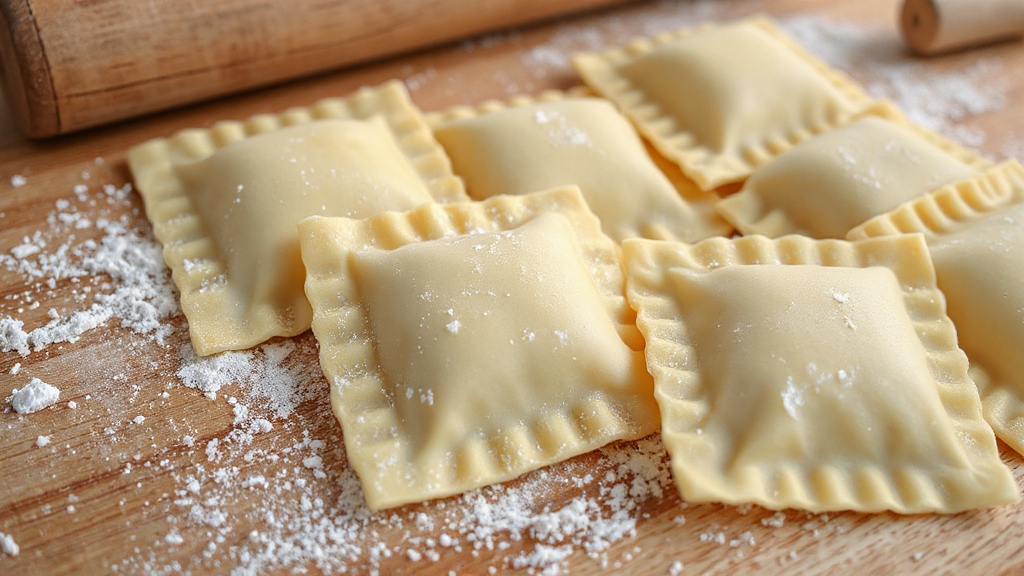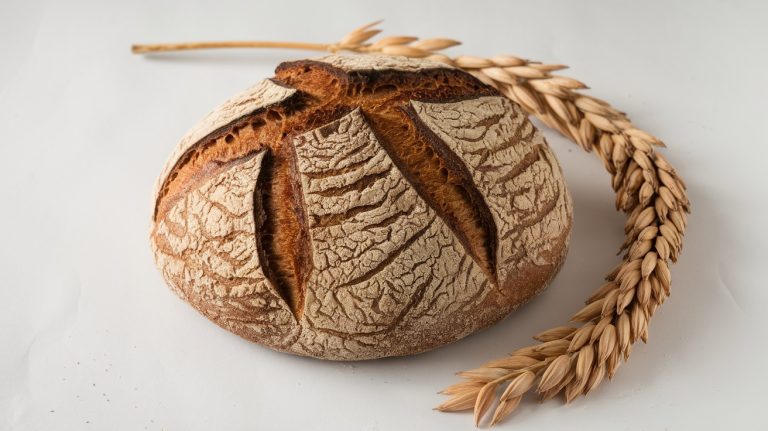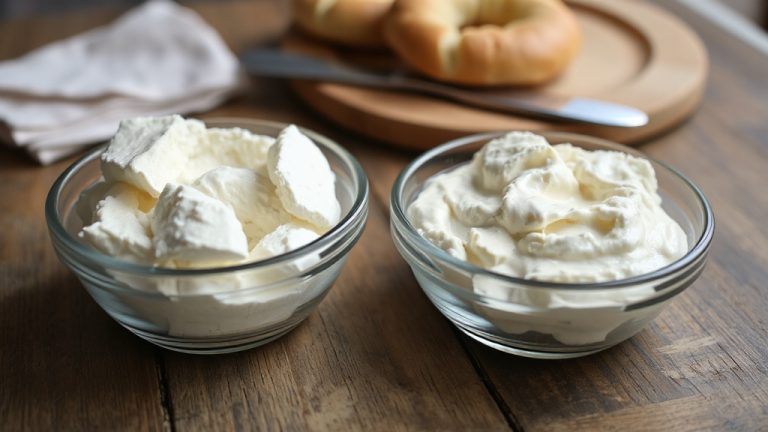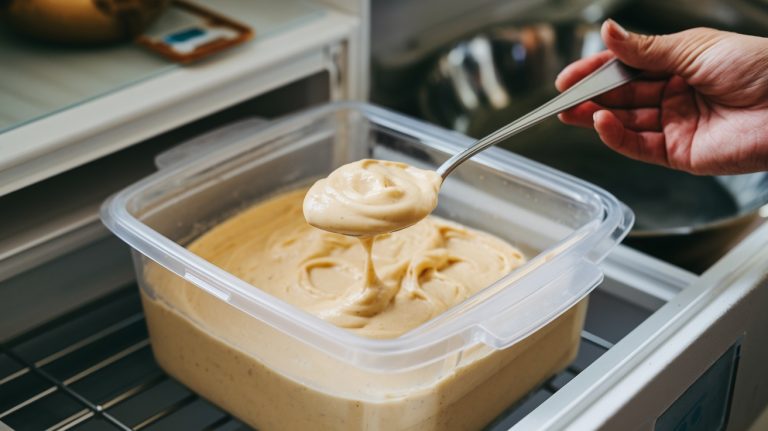Ravioli Pasta Dough: From Prep to Plate
Imagine creating restaurant-quality ravioli that rivals your favorite Italian trattoria—all from your own kitchen. Making perfect ravioli pasta dough isn’t just about mixing flour and eggs; it’s about understanding the precise science behind hydration ratios, gluten development, and traditional Italian techniques that transform simple ingredients into silky, elastic perfection.
This comprehensive guide reveals the professional secrets that separate amateur attempts from masterful pasta, including the crucial 55-57% hydration ratio that ensures your dough stretches without tearing, the importance of Tipo 00 flour for authentic texture, and expert timing techniques for kneading and resting.
You’ll discover why proper gluten development makes all the difference, learn troubleshooting solutions for common dough disasters, and master storage methods that keep your pasta fresh.
Whether you’re a beginner intimidated by homemade pasta or an experienced cook seeking to perfect your technique, these time-tested methods will transform your ravioli-making skills forever.
Key Takeaways
- Use 300-400g Tipo 00 flour and 3-4 whole eggs plus yolks for smooth, elastic ravioli dough with balanced hydration (55-57%).
- Mix flour and eggs gently, knead 1-2 minutes, then rest dough 30-60 minutes to improve elasticity and workability.
- Roll dough evenly using a pasta machine through multiple settings for consistent thickness and texture.
- Cut ravioli with fluted cutters or stamps, dusting with semolina to prevent sticking during shaping and drying.
- Store fresh ravioli covered at room temperature or freeze on trays to maintain freshness and prevent drying out.
Quick Ravioli Dough Recipe Table
| Ingredients | Process |
|---|---|
| 300-400g Tipo 00 flour | Create a well in the center of flour on clean work surface |
| 3-4 large eggs (185g total) | Crack eggs into the well and beat gently with fork |
| 1-2 extra egg yolks | Gradually incorporate flour from edges into eggs |
| 1-2 tbsp olive oil | Add olive oil if mixture needs more moisture |
| Pinch of salt | Mix salt with flour before creating well |
| Semolina flour for dusting | Use for dusting work surface and storing pasta |
Essential Ingredients for Perfect Ravioli Dough
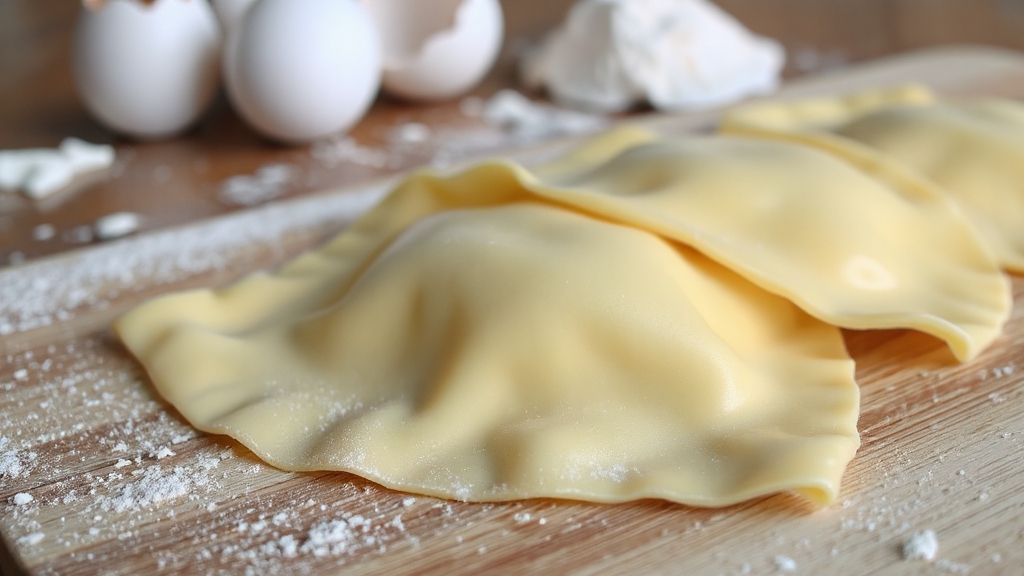
Although making perfect ravioli dough may seem challenging, understanding and selecting the essential ingredients will set you on the right path. Start with 300-400 grams of Tipo 00 flour, prized for its fine texture and low protein, which ensures smooth, tender pasta. If unavailable, all-purpose flour works but may need slight adjustments.
Use 3-4 whole eggs plus extra yolks to reach about 185 grams total; they provide moisture, richness, and binding. Add a pinch of salt to enhance flavor and strengthen gluten. Incorporate a small amount of olive oil to improve dough softness and flexibility.
Finally, keep semolina flour on hand for dusting to prevent sticking during rolling. These ingredients, balanced correctly, create a smooth, elastic dough ready for shaping. It is also important to let the dough rest for 30 to 60 minutes to relax the gluten, making it easier to roll out and work with resting period.
Step-by-Step Dough Preparation Process
Once you have gathered and measured your ingredients, you’re ready to begin preparing the dough. Start by placing flour on a clean surface and create a well in the center. Crack eggs into the well and use a fork to gently mix them, gradually incorporating flour from the edges.
After most flour is combined, add water or olive oil if your recipe calls for it. Pull in the remaining flour until a rough dough forms, adjusting moisture as needed. It is important to weigh the eggs to ensure consistent results in your dough. Using a cake turntable can help maneuver the dough easily during preparation and shaping.
Transfer the dough to a floured surface and knead for 1–2 minutes until smooth and elastic but slightly sticky. Cover the dough and let it rest for 15–60 minutes to relax the gluten, which eases rolling and prevents tearing during shaping.
Recommended Tools for Making Ravioli Dough
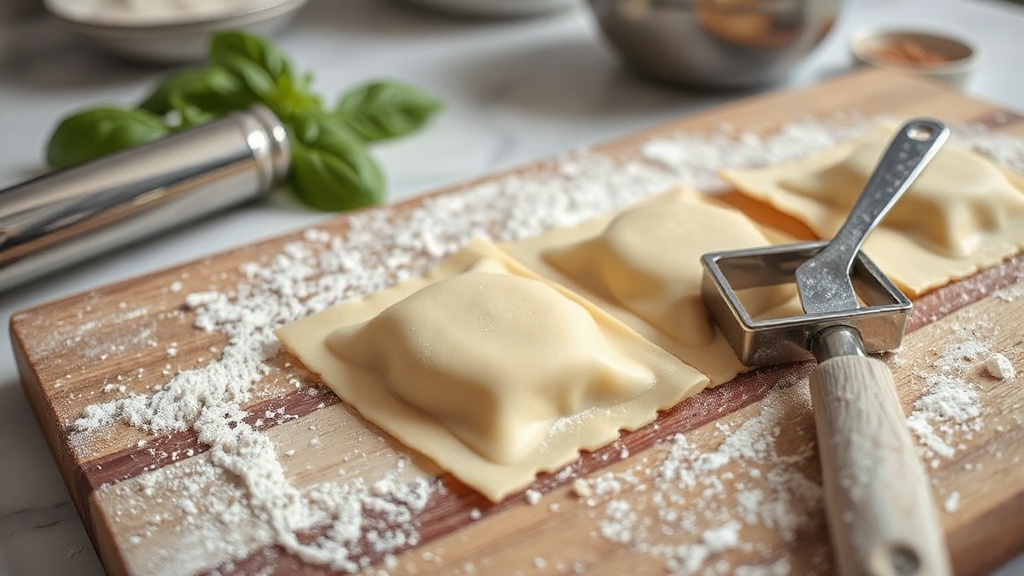
To make perfect ravioli dough, you’ll need essential tools like a pasta machine for rolling thin sheets and a digital scale to measure ingredients precisely.
Use a fluted pastry cutter or sharp knife to cut dough into uniform shapes, ensuring even cooking. Having these tools on hand will streamline your process and improve the quality of your pasta. A fluted wheel creates decorative edges on pasta dough, adding a professional touch to your ravioli.
Essential Pasta Equipment
When preparing ravioli dough, having the right tools makes all the difference in achieving smooth, even sheets and perfectly shaped pasta. Start with a quality pasta machine to roll your dough uniformly; this ensures consistent thickness essential for ravioli.
Use a dough scraper to handle and transfer dough easily while keeping your workspace clean. A flour shaker helps maintain an even dusting of flour, preventing sticking during rolling.
For shaping, a ravioli cutter or stamp guarantees precise, uniform pieces. Work on a sturdy wooden or gnocco board to provide stability.
After cutting, a drying rack keeps ravioli separated to avoid sticking. Investing in durable, specialized tools not only improves your results but also simplifies the pasta-making process, making it more enjoyable and efficient. For best results in ingredient preparation, consider using a digital baking scale to measure flour and liquids precisely.
Measuring and Cutting Tools
Having the right equipment for shaping ravioli is only part of the process; accurate measuring and precise cutting tools guarantee your dough performs perfectly. Use precision measuring cups, digital scales, and thermometers to ensure consistent dough texture.
For cutting, choose pasta cutters with adjustable spacers or round ravioli cutters for uniform shapes. Stainless steel and food-grade plastic tools offer durability and safety. Using wet hands to create dimples in dough is a technique that ensures even absorption of fillings and toppings in bread making.
Ergonomic handles and interchangeable blades improve comfort and versatility. The Professional Ravioli and Pasta Flower Stamp by La Gondola, made from Brass and Natural Wood, is an excellent addition for those seeking authentic Italian craftsmanship in their pasta-making tools.
| Tool Type | Material Options | Key Features |
|---|---|---|
| Measuring Tools | Stainless steel, plastic | Digital scales, thermometers |
| Cutting Tools | Stainless steel, Delrin | Adjustable spacers, embossing |
| Handle Types | Wood, plastic | Ergonomic grips, durable |
| Brands | La Gondola, ORBLUE | Professional quality |
Key Characteristics of High-Quality Pasta Dough
Although crafting high-quality pasta dough demands attention to detail, mastering its key characteristics guarantees a superior final product. To achieve dough perfect for ravioli, focus on texture, flavor, and workability.
Your dough should be smooth and elastic, with balanced hydration to prevent dryness or stickiness. Using quality ingredients like egg yolks and 00 flour enriches flavor and creates silkiness. Proper gluten development ensures the dough stretches without tearing, which is essential for shaping ravioli.
Additionally, the protein content of the flour plays a crucial role in providing the right balance between elasticity and plasticity. Incorporating sourdough starter into the dough can enhance flavor and improve gluten digestibility.
Key traits to focus on include:
- Smooth, cohesive texture without dry patches
- Elasticity that allows easy rolling and shaping
- Balanced hydration for pliability
- Flavor enhanced by egg yolks and salt
- Uniform thickness for even cooking
Mastering these ensures your ravioli dough performs beautifully.
Expert Tips to Enhance Your Dough-Making Skills
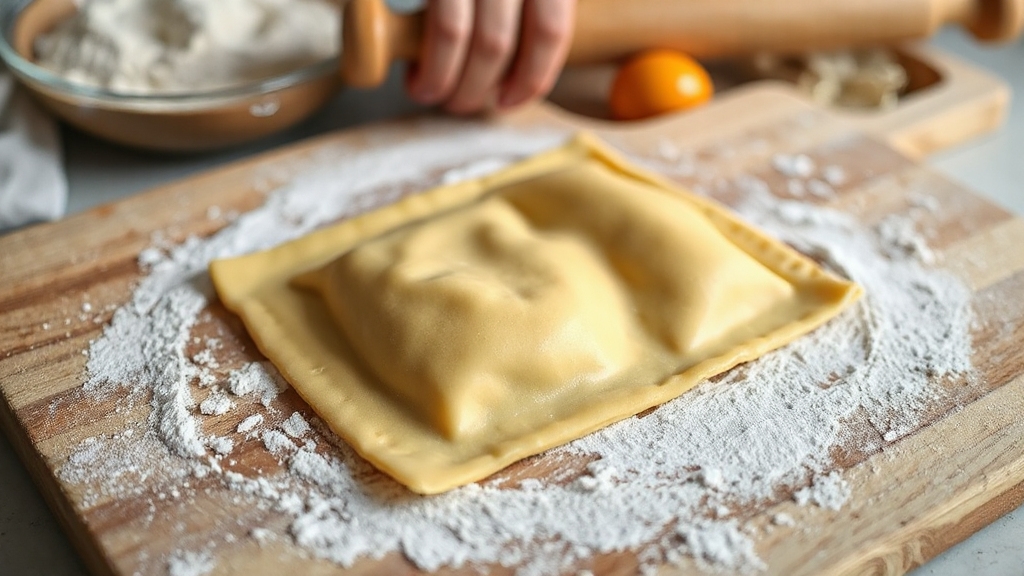
Perfecting ravioli dough goes beyond understanding its key characteristics—you can elevate your skills by applying expert tips throughout the dough-making process. Use fresh eggs and high-quality “00” flour to improve texture and flavor. Add olive oil for suppleness and a pinch of salt to enhance taste.
Mix ingredients using a food processor or stand mixer for efficiency, but don’t skip resting the dough for at least an hour to relax gluten. Resting also helps reduce dough stickiness, making it easier to handle. Rolling dough evenly with a pasta machine ensures uniform thickness and prevents overworking, which can lead to tough dough.
For best results, maintain precise measurements and consider factors like hydration and resting time to improve dough elasticity and texture, similar to techniques used in gluten-free sourdough fermentation.
| Step | Tip | Benefit |
|---|---|---|
| Ingredients | Fresh eggs & “00” flour | Better texture & flavor |
| Mixing | Food processor or mixer | Quick, consistent mixing |
| Resting | Rest dough 1+ hour | Easier rolling, tender dough |
| Rolling | Use pasta machine | Uniform thickness |
| Handling | Avoid overworking | Prevents tough dough |
Common Challenges and How to Overcome Them
When you make ravioli pasta dough, you’ll encounter common challenges like incorrect hydration, overkneading, or dough drying out. To overcome these, focus on balancing moisture and texture precisely. Use these tips:
Master ravioli dough by balancing moisture and texture, avoiding overkneading, and preventing drying for perfect pasta.
- Adjust egg or water amounts if dough feels sticky or dry. Aim for a hydration ratio of 55-57% to achieve the ideal dough consistency.
- Knead just enough—overkneading toughens the dough, underkneading limits elasticity. Similar to bread mixes, proper kneading affects texture and rise, so avoid overworking the dough to maintain softness.
- Rest the dough to enhance pliability before rolling it thin.
- Work in small batches, covering unused dough to prevent drying and cracking.
- Roll dough through multiple settings for consistent thickness, ensuring even cooking. This method mirrors how consistent preparation techniques improve outcomes in mixes like Krusteaz Sourdough Bread Mix.
Proper Storage and Handling of Ravioli Dough
Managing ravioli dough beyond mixing and kneading requires careful attention to storage and handling to maintain its texture and prevent spoilage. Keep fresh dough tightly wrapped at room temperature for no more than 1-2 hours to avoid drying.
Arrange cut ravioli spaced on a semolina-dusted, parchment-lined tray, covering loosely with a damp cloth to retain moisture. For longer storage, refrigerate dough or assembled ravioli for up to 4 hours, always sealed to prevent drying. However, refrigeration is not recommended for extended periods due to stickiness and spoilage risks.
Avoid overnight refrigeration to prevent discoloration and sogginess. To freeze, air-dry ravioli about 45 minutes until dry, then freeze individually on trays. Transfer the frozen ravioli to airtight containers or double-pack to prevent freezer burn.
Cook frozen ravioli directly without thawing, adding minimal cooking time. Proper handling ensures perfect texture and flavor retention.
Frequently Asked Questions
Can I Use Gluten-Free Flour for Ravioli Dough?
Yes, you can use gluten-free flour to make ravioli dough, but you’ll need to adjust your approach. Choose a good gluten-free flour blend that includes xanthan gum or add it separately to improve elasticity.
Use eggs and olive oil to strengthen and moisten the dough. Handle it gently, dusting with flour to prevent sticking, and roll carefully.
Be patient, as gluten-free dough can be more delicate and prone to tearing, but it’s definitely doable.
How Do I Prevent Ravioli From Sticking Together After Cooking?
Imagine a cluster of ravioli clinging like shy dancers in a crowded room—that’s what you want to avoid. To keep them separate after cooking, rinse them gently with cold water to stop the cooking and cool them down.
Use a slotted spoon to transfer them carefully to a tray dusted with rice flour. Serve promptly, and avoid adding sauce right away so they don’t stick together.
What’s the Best Filling to Pair With Homemade Ravioli Dough?
You’ll want a filling that complements the delicate texture of your ravioli. Classic ricotta mixed with fresh herbs like basil or parsley offers a creamy, flavorful option that’s easy to prepare.
If you prefer something heartier, try a blend of ground Italian sausage with Romano cheese and a touch of nutmeg for warmth.
For a fresh twist, roasted butternut squash with sage adds seasonal sweetness and depth to each bite.
Can Ravioli Dough Be Frozen Before Filling and Cooking?
Imagine freezing your dough like a preserved scroll in the Renaissance—yes, you can freeze ravioli dough before filling and cooking. Dust it lightly with flour, wrap tightly in plastic or an airtight bag, and freeze for up to 30 days.
When ready, thaw slowly in the fridge to keep it workable. Avoid freezing dough with fillings, as moisture disrupts texture.
This method gives you flexibility and reduces waste while preserving quality.
How Do I Reheat Leftover Ravioli Without Drying It Out?
To reheat leftover ravioli without drying it out, preheat your oven to 350°F and place ravioli in a baking dish. Add a splash of water or stock, then cover with foil to trap moisture. Heat for about 20 minutes, checking occasionally.
Alternatively, warm ravioli in a non-stick skillet over low heat with a bit of olive oil, tossing gently. Avoid high heat and keep ravioli covered or sauced to maintain tenderness.
Your Blueprint to Ravishing Ravioli Every Time
Mastering ravioli dough takes patience and practice, but remember, “Rome wasn’t built in a day.” By using the right ingredients, following each step carefully, and employing proper tools, you’ll create a smooth, elastic dough that holds fillings beautifully.
Don’t rush—embrace each challenge as a learning opportunity. Store your dough correctly to keep it fresh and workable. With these tips, you’ll consistently craft perfect ravioli that impress every time.

